IN THIS ISSUE
- Right whales: What you need to know
- Why weather loaches aren't welcome
- Winter survival and woodpecker cavities
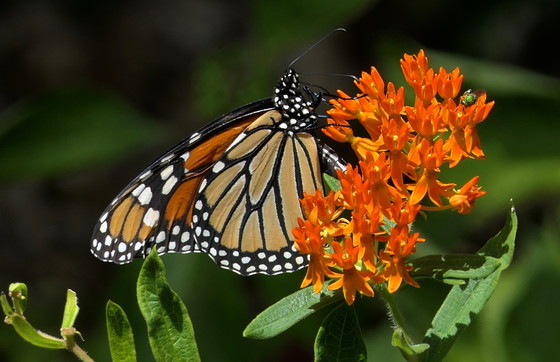 Winter watch is on for monarchs in Georgia and other states (Linda May/DNR)
Each fall, monarch butterflies stream by the thousands across the southern U.S., bound for wintering grounds in Mexico. Come spring, this eastern population of the iconic butterflies will return to the U.S. and Canada to breed.
But not all monarchs migrate to Mexico. Some overwinter in the South. And some of those butterflies breed here.
Researchers want to know where, why and what this might mean for monarchs, an insect in decline and a candidate for Endangered Species Act listing.
This is where the public's help is needed.
Journey North, Monarchs Across Georgia, the University of Georgia and DNR are encouraging the public to report monarch sightings from now through March in Georgia and eight other coastal southern states, from Texas to North Carolina.
Studies show that monarch migration has changed in recent years. Understanding how and the species’ overwintering behavior is key to conserving monarchs.
Report sightings at journeynorth.org/monarchs.
More on this project (news release) and North American monarch ecology and conservation (free e-book).
LISTING WARRANTED, BUT LATER
The monarch warrants federal Endangered Species Act protection but that change is on hold because dealing with other evaluated species first is a higher priority.
The U.S. Fish and Wildlife Service said this week the warranted-but-precluded decision makes the monarch a candidate for listing (the same as the gopher tortoise east of Mobile Bay). The butterfly’s status will be reviewed each year until it changes.
Top
 Right whale "Chiminea" and her calf off Cumberland Island (Clearwater Marine Aquarium/NOAA permit 20556-01)
Recent sightings of three North Atlantic right whale calves off the Georgia/Florida coast stirred hope that right whales will post a strong calving season this winter.
Yet that hope is tinged with the sobering knowledge that these imperiled whales will require much more to avoid extinction. Here’s a brief overview.
Status: The population declined from an estimated 477 whales in 2011 to 366 in January 2019. There are fewer than 100 breeding females left. (Adult females drive population growth.) And in the past 10 years the number of calves per year has dropped to half the annual average – 24 – born the previous decade.
Deaths: Since 2017, 32 dead right whales have been found in the U.S. and Canada. The leading cause: “human interaction” from entanglements in commercial fishing rope or vessel strikes. Another 13 whales still alive have been documented with serious injuries from entanglements or strikes. Deaths are up, calving is down. “The math is pretty simple,” said Clay George, a DNR senior wildlife biologist.
Issues: Shipping traffic remains thick along the Atlantic seaboard. Millions of lobster and crab traps are set in New England and Canadian waters each year. Warming oceans have commercial fishers moving to deeper water, increasing the risk of whale entanglements. Stronger fishing rope is worsening whale injuries. Meanwhile, the life span of adult female right whales has shrunk and intervals between calving have increased. The male/female ratio has grown to almost 2-to-1.
Outlook: A proposed federal rule to reduce entanglements is in the works, spurred in part by a lawsuit. (Amidst the legal wrangling, the Gulf of Maine lobster fishery saw its sustainable certification suspended in August.) Massachusetts is holding hearings on reducing entanglement risks. Work is being done to develop “ropeless” fishing systems that either eliminate buoy ropes or keep them out of the water column.
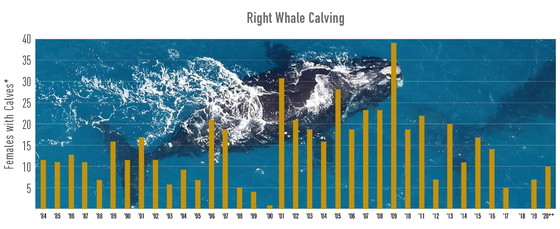 What DNR is doing: The agency is again teaming with NOAA, Clearwater Marine Aquarium and the Florida Fish and Wildlife Conservation Commission to monitor right whales this winter by plane and boat. (The only known calving area for right whales is off the coast of Georgia and north Florida.) Calves will be biopsied for genetics research. George and staff will also help in any disentanglement efforts.
What you can do: Inform yourself, including about sustainable seafood. Support right whale conservation in Georgia. When boating November-March, be on the lookout and slow down for right whales. Stay at least 500 yards away and report sightings at 877-WHALE-HELP (877-942-5343).
The last word: “I’m still optimistic,” George said. “In the 2000s, we saw how quickly the population can grow if mortality is managed and females have lots of calves. If we can slow ships down in the right places, and remove heavy fishing rope from their habitat, the whales would have a fighting chance.”
For more: What does it mean to lose a right whale mom?
Top
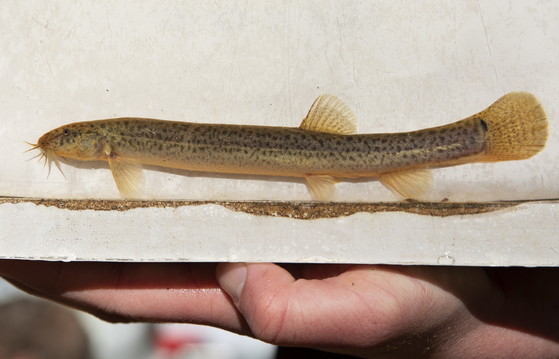 An Oriental weather loach caught in McNutt Creek near Athens (Andrew Davis Tucker/UGA)
By ANI ESCOBAR and JIM PAGE
At first glance, the fish looks unassuming. Its chin barbels remind you of a catfish. Its spots suggest something tropical. Usually less than a foot long, this mild aquarium pet has a face of innocence.
However, the Oriental weather loach – documented for the first time in the wild in Georgia last month – could spell trouble for aquatic ecosystems across the state.
Also called the dojo or pond loach, this Asian species and popular aquarium fish has been introduced to Europe, Australia and at least 13 states in the U.S., including Alabama and Tennessee.
While sampling for Altamaha shiners in early November, UGA researchers were surprised to find several loaches in McNutt Creek, a tributary to the Middle Oconee River near Athens. After identifying the mystery catch, they worked with DNR to explore the fish’s status in the creek.
As part of that cooperative plan, the team did more sampling and collected at least 15 more loaches. That catch ramped up concerns about impacts the species might have if it is established and reproducing. ...
Read more about weather loaches and possible threats on DNR's blog.
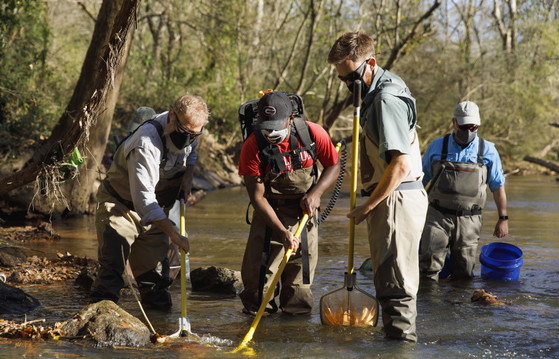 UGA crew searches for weather loaches (Andrew Davis Tucker/UGA)
Ani Escobar is a DNR aquatic biologist focused on conservation in the Coosa River Basin. Jim Page is DNR's aquatic nuisance species coordinator for Georgia.
Top
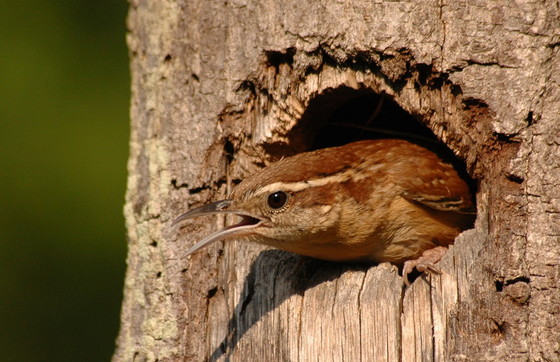 Carolina wren in a cavity (Todd Schneider/DNR)
By TERRY W. JOHNSON
I have long been intrigued by relationships that link different wildlife species. One such association is between woodpeckers and a suite of unrelated birds found in backyards across Georgia.
The connection is cavities. Those chiseled out by woodpeckers are frequently used by birds that cannot create their own. But while that usually involves nesting, in winter these cavities excavated in dead limbs and dead and dying trees can provide critical winter-roosting habitats for some birds.
On an extremely cold night, a roost can be the difference between living and dying.
Unfortunately, suitable winter-roosting cavities are in short supply ...
Read Terry’s column to learn why there’s a shortage and how you can help.
Terry W. Johnson is a retired DNR program manager and executive director of TERN, the Wildlife Conservation Section’s friends group. Check out past columns, his Backyard Wildlife Connection blog and his book “A Journey of Discovery: Monroe County Outdoors.” His columns are also featured on DNR’s blog, under the Conservation tab. Permission is required to reprint any of Terry’s columns.
Top
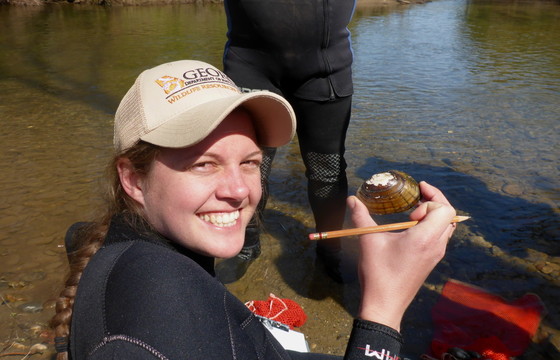 DNR's Ani Escobar surveying mussels (DNR)
Aquatic species and watersheds in Georgia will benefit from more than $715,000 in grants announced by the National Fish and Wildlife Foundation, the USDA’s Natural Resources Conservation Service and Forest Service, the U.S. Fish and Wildlife Service, and Southern Co. The following Southeast Aquatics Fund projects will also leverage $1.4 million in habitat restoration and enhancements.
- Limestone Valley Resource Conservation and Development Council: $256,304 to work with landowners on best management practices to improve water quality for the recovery of 10 listed fish and mussel species in the Conasauga River watershed in Georgia and Tennessee.
- The Nature Conservancy: $75,000 to replace six culverts on Holly Creek in the Chattahoochee National Forest, boosting federally threatened blue shiners and state-endangered bridled darters.
- Georgia DNR: $65,747 to monitor bridled darters, villosa mussels and other species in Holly Creek to better understand these populations and their response to management activities.
- Southeastern Association of Fish and Wildlife Agencies: $205,000 for irrigation practices in Radium Springs that reduce water use and help Gulf sturgeon, Georgia blind salamanders and others.
- Tennessee Aquarium: $113,097 to monitor bridled darters and assess threats to blue shiners in the Coosa River drainage in Alabama, Georgia and Tennessee.
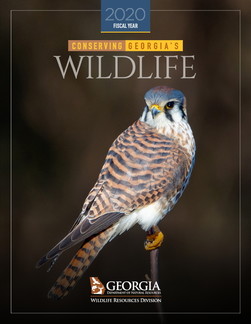
What did conserving Georgia’s rare animals, plants and natural habitats look like in fiscal year 2020? From American kestrels to Canby’s dropwort and Suwannee alligator snapping turtles, find out in the just-released annual report from the DNR Wildlife Conservation Section.
Hammerhead worms are making headlines. Although these land planarians native to Asia and also called shovel-headed garden worms have been in Georgia for years, the media interest has been fueled by their potential size – they can grow up to a foot long – and significant ick factor. Report sightings.
Teachers and K-5 students can celebrate Georgia wildlife through art by taking part in the Give Wildlife a Chance Poster Contest. The “Nature Is Everywhere” theme of the 31st annual competition sponsored by DNR, the State Botanical Garden of Georgia and The Environmental Resources Network emphasizes that native wildlife and plants can be enjoyed close to home or far away.
Sprewell Bluff is being spruced up. DNR’s west-central Georgia fire crew burned about 750 acres on the two-part wildlife management area near Thomaston, prepping the site for planting longleaf and shortleaf pines, while also treating another 350 acres for invasive Vasey grass.
A new female bald eagle is settling into the Berry College nest streamed online, raising questions about whether she will be the popular nest’s new momma. The former resident female, who had noticeable injuries to her left foot suffered in 2013, has not been seen this fall. Stay tuned.
Top
|
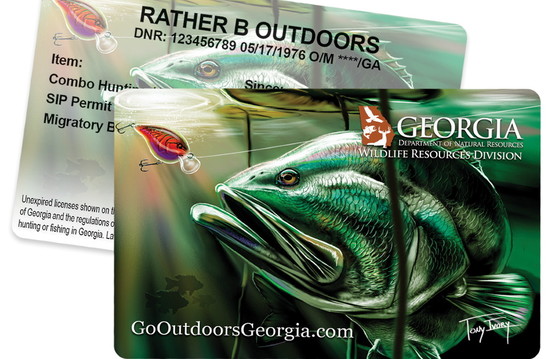 Looking for a wild gift? Georgia hunting and fishing licenses – including collector card versions – provide sporting privileges, offer access to most state-managed lands and return to DNR a greater share of federal Wildlife and Sport Fish Restoration funds for wildlife management. Buy online.
A patch of imperiled Porter’s goldenrod found in metro Atlanta is the only known occurrence of the plant in Georgia and one of only two in the species’ range. With the landowner's permission, a clump acquired by DNR will be grown and hopefully increased at the State Botanical Garden of Georgia.
Head’s up, landowners: DNR has updated its landowner’s guide to conservation resources. This comprehensive booklet provides key details and contacts on wildlife and habitat programs featuring technical and financial assistance as well as incentives for managing private lands and native wildlife.
The Youth Christmas Bird Count at Charlie Elliott Wildlife Center on Saturday logged 37 bird species, from white-throated sparrows to great blue herons. The yearly event included nearly 30 people searching for birds in the wild and learning more in a raptor program by Charlie Elliott’s Cheyenne Whitetree.
Top
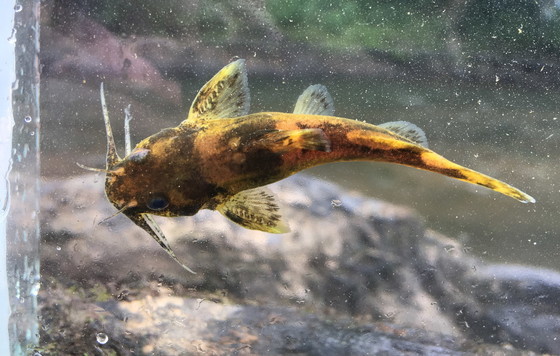 Frecklebelly madtom (Brett Albanese/DNR)
Frecklebelly madtom is a small catfish attracting significant attention. An upper Coosa River population of the 3-inch-long fish purportedly named for jabbing careless handlers with its spines is proposed for listing as federally threatened in Georgia and Tennessee.
Names in the news: DNR Law Enforcement Game Warden First Class Colte Shaske and Cpls. Jay Bright and Jordan Crawford were recognized for heroism at the recent Governor's Public Safety Awards. Shaske and Bright rescued two crew members of the Golden Ray as the cargo ship rolled over in St. Simons Sound last year. Before sunup Jan. 26 on the Ogeechee River, Crawford rescued three people, one suffering from severe hypothermia, whose boat had capsized and were clinging to trees in swift current. The South Carolina Department of Natural Resources' Felicia Sanders received the Biologist of the Year Award from the Southeastern Association of Fish and Wildlife Agencies. Sanders, Coastal Bird Conservation Project supervisor for the agency, is considered a coastal birds champion whose work has improved the understanding and conservation of these species.
WHAT YOU MISSED ...
In the previous Georgia Wild:
- A winter bird-feeding strategy
- Invasion of the Cuban treefrogs
- New Georgia darter discovered
Top
"Open Space Institute makes fourth property acquisition in Georgia," The Augusta Chronicle
"The virus, the bats and us," The New York Times
"Right whale and calf spotted near Hilton Head," WTOC-TV (Savannah). Other right whale coverage: "Two newborns" (CNN), "Rare calf strands in N.C." (Fox), "Youth kick off Whale Week" (The Brunswick News), "Fishing gear confirmed as major cause of deaths" (Canadian Broadcasting Corp.).
"DNR botanist earns award for Oconee park garden," The Oconee Enterprise
(+video) "Federal grand jury indicts Georgian of using illegal nets to trap, export turtles," WXIA-TV (Atlanta). Also: "Marietta man sentenced for smuggling endangered turtles into U.S." (WXIA-TV), "Inspection dogs save turtles, uncover smuggling operation" (U.S. Fish and Wildlife Service).
"Ga. researchers want help spotting monarchs this winter," WABE-FM (90.1, Atlanta). Also: Moultrie Observer.
"Feds to delay seeking legal protection for monarchs," Associated Press
"Invasive fish discovered in Georgia creek," Phys.org
"Watch for Cuban treefrogs in Georgia, scientists warn," GPB
(+audio) "Invasive tegu lizards eating their way through Southeast," WBUR-FM (90.9, Boston). Also: National Geographic, Daily Mail, CNN.
"Invasive lizard with appetite for butterflies spreads in Fla.," Tampa Bay Times
"State poster contest draws attention to nature," Main Street Newspapers
"Learning adventures (Wheeler County Youth Leadership Program)," including DNR's Matt Elliott, Vidalia Advance
"DNR announces grants for wildlife-viewing projects," Gwinnett Citizen
"Grant to improve fish habitat on Chattahoochee-Oconee," The Chatsworth Times
"Raccoon once a Thanksgiving feast fit for a president," Smithsonian Magazine
Top
 "Birding in Georgia," DNR
"'Entangled' right whale film: post-screening discussion," Pulitzer Center
(audio) "Challenge of saving right whales, protecting lobstermen’s livelihood," NEXT (New England News Collaborative)
(webinar) "What does a changing climate mean for Georgia ecosystems?" Georgia Climate Project
Top
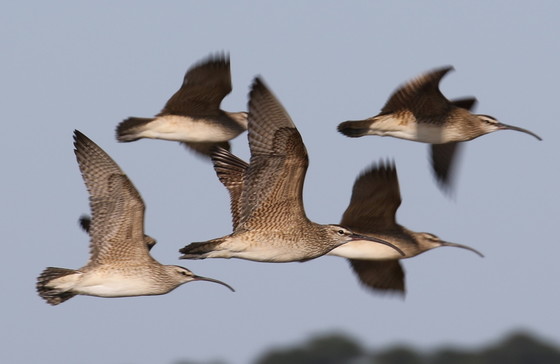 Whimbrel migration reveals ties between Georgia and research into the warming Arctic (Tim Keyes/DNR)
If birds earned frequent-flyer miles, whimbrels would rack them up. Thousands of these big-bodied shorebirds migrate through Georgia each spring and summer, flying between nesting sites in the Arctic and wintering grounds at the mouth of the Amazon River. (Feeding up just before migration, whimbrels look like footballs with wings, says DNR wildlife biologist Fletcher Smith.) A new study of some 200 animal tracking studies explores how climate change in the Arctic and subarctic is affecting such migrants. The paper on the Arctic Animal Movement Archive, which includes whimbrel data from Smith, focuses on golden eagles, caribou and terrestrial mammal movements. Yet whimbrels reveal the ties between the Arctic and Georgia – whose barrier islands rate as a “landscape of hemispheric importance” for shorebirds – and the extensive network of partnerships committed to conserving such far-ranging species. This spring, DNR will add to its whimbrel work, using radio tags to better document how the birds use Georgia as a vital stopover to feed and rest. More on whimbrels in this story map by Manomet.
Top
|